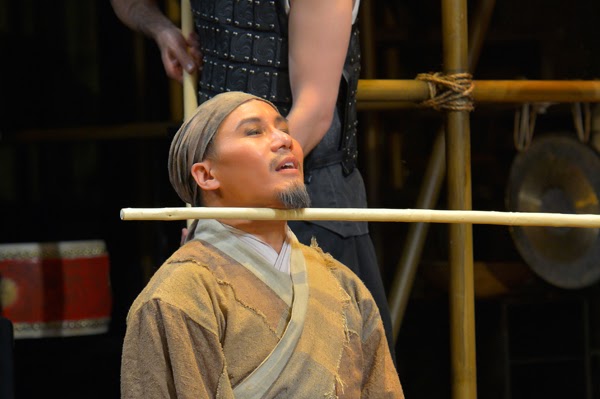ZHAO BUSINESS: THE ORPHAN DIARIES OF BD WONG - PART 4
ZHAO BUSINESS: THE ORPHAN DIARIES OF BD
WONG - PART 4
SECOND AND THIRD DAY IN THE THEATER: TECH-TEQUE
 |
| BD WONG Photo by Kevin Berne |
So, you have a finite amount of time to
tech a show. Tech-ing a show means that you take the performance of the play
that the actors have rehearsed in the rehearsal room, bring it into the
theater, and then spend that finite amount of time prior to the final dress
rehearsal adding every remaining technical element that gives the production
its physical identity. Months or sometimes years before a production goes into
technical rehearsals, designers are preparing their work. Director Carey
Perloff shared costume designer Linda Cho’s wonderful costume designs with me
back in February. These were completed and did not change much subsequently, so
Linda and Carey were undoubtedly collaborating on their ideas well before. Dan
Ostling and composer Byron Au Yong probably were also in conversation with
Carey sometime in 2013 (I hear Byron started doing musical sketches almost
immediately, and that Carey and Dan “storyboarded” the entire play—choosing a
scenic identity for each of the many scenes—for about a year). Lap Chi Chu, as
lighting designer, probably does his most intensive work once an initial scenic
concept is established, and his work becomes a collaborative response to that,
as well as to Carey’s direction and Linda’s costumes. Jake Rodriguez is the
sound designer and not only designs the entire equipment plot for the
enhancement of the actors’ voices through artful miking (we have challenges
balancing our particular show as the actors’ voices need to be heard over loud
percussion instruments, for example), but he also works with Byron on the
soundscape (i.e., sound effects). Sound design is the unfortunate, neglected sibling of the design family, as it
is a design element underappreciated by nearly everyone. Perhaps this is
because sound does not have a tangible entity, something you can look at or
touch. There is no excuse for omitting the value of a good sound designer’s
contribution to a production while one gushes over the lighting, scenery, and
costumes.
 |
| Daisuke Tsuji, Paolo, Montalban, and Cindy Im Photo by BD WONG |
Everything is either about you
(and your—or your character’s—track of whatever show it is that you’re doing).
. . .
. . . Or everything is about you
(and your—or your character’s—track of whatever show it is that you’re doing).
Those are the two choices; pick one.
This is because you are about to put
yourself on the line and go out there in front of paying people in a rather
exposed way, so you are somewhat vulnerable to worrying about whether or not
the new elements—the clothes, what you’re standing on, what you’re hearing,
everything else—is going to mess you up in any way. If something
does mess you up, then you worry whether or not it will be the permanent kind
of messing up or the kind of messing up that you can deal with gracefully if
you make a manageable adjustment. Usually the tech phase of a production
coincides with both the final stage of committing the text to memory, as well
as a growing comfort with the staging after working on it for weeks, and I find
that this is the time when I am the most stressed out. It’s challenging to be
trying to get your brain to install the text in a text-challenging play to a
word-perfect place, right at the time when the physical elements are being
introduced to you—i.e., change.
An A.C.T. donor was so tickled to relate
to me how fascinated she was when she was once able to attend a tech rehearsal
as an observer. “And then the stage manager came out and told us, ‘Watch this,
the actors are all going to complain about their props; some of the props are
still being built and the actors are not going to be happy. . . .’ And sure
enough, wouldn’t you know, the actors all came out and said ‘Where’s my this?’
and ‘Where’s my that?’ and ‘Is this how it’s going to be?’ It was
so interesting!”
This isn’t totally fair, though. The
rehearsal process is usually closed so that actors can work these things out in
privacy. Furthermore, it can’t be overstated how important an actor’s
familiarity with a prop that she is working with is when you consider that effortlessness
is her ultimate goal. In our show, for example, there is one particular prop—an
old fashioned medicine chest—that must not only hold a variety of other props
within it with a minimum of “scrounging around for it,” but it must also be
handled by two actors at different times in very different ways: one gets
things in and out of it many times, and the other must climb the three-story
set with it strapped to his back. The prop has to work for both of them, and
they each in turn must rehearse with it, so that their dealings with it are not
in the least bit awkward in front of an audience, or in some cases, even
unsafe.
To learn more about A.C.T.'s production of The Orphan of Zhao and to buy tickets visit act-sf.org/orphan.
To learn more about A.C.T.'s production of The Orphan of Zhao and to buy tickets visit act-sf.org/orphan.

